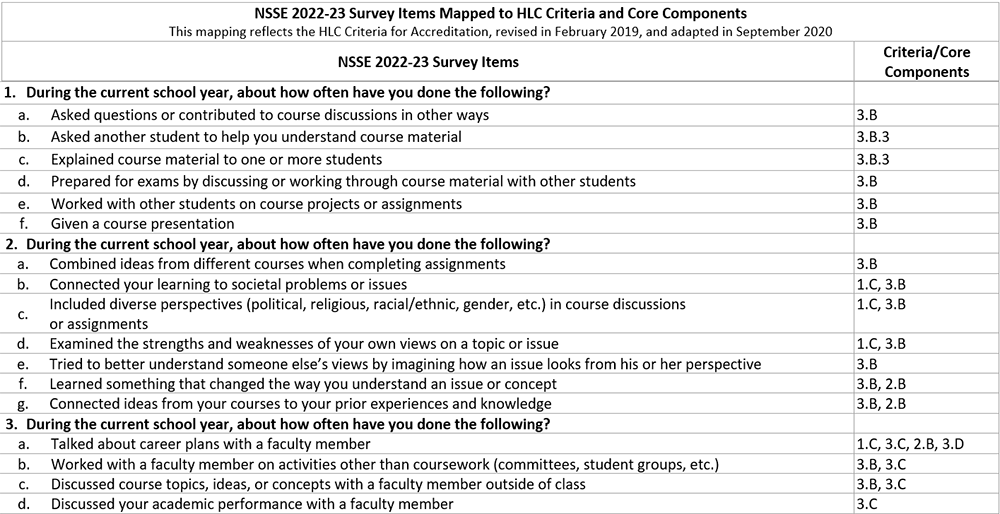| Table 1. Excerpt from NSSE HLC Accreditation Toolkit: NSSE Items Mapped to HLC Criteria |
 |
Equity Emphasis in Accreditation
An important development in accreditation criteria lies in its expanded focus on equity andinclusion at the institution level and throughout the standards. While the six major accreditors have diversity and equity metrics in their standards, several have expanded this emphasis. For example, one of five guiding principles across all seven Middle States Commission on Higher Education (MSCHE) standards is “Reflection on Diversity, Equity, and Inclusion.” One goal of this reflection is to address disparate impacts by student populations if discovered. In another explicit example, WASC Senior College and University Commission (WSCUC) states that institutions should ensure approaches to student support “promotes the success of all students, and makes explicit its commitment to diversity, equity and inclusion.” The Southern Association of Colleges and Schools Commission on Colleges (SACSCOC) specifies in Standard 8.1 (Student achievement), “that institutions will disaggregate graduation rate data by gender, ethnic, socioeconomic…” to guide strategies for improvement.
NSSE results can provide evidence for these expectations for equity and inclusion in accreditation. Many student engagement items map directly to educational goals for diverse learning experiences, including the Discussions with Diverse Others Engagement Indicator, while other items assess a supportive environment, such as, the institution encourages “contact among students from different backgrounds (social, racial/ethnic, religious, etc.)” and gains items including, “understanding people of other backgrounds (economic, racial/ethnic, political, religious, nationality, etc.)” that could offer evidence of equitable support or suggest areas for improvement. Western Illinois University, for example, featured 3 years of NSSE data in their Higher Learning Commission (HLC) Assurance Argument report for Core Component 3.B.3: “The education offered by the institution recognizes human and cultural diversity and provides students…skills to live and work in a multicultural world.” Western Illinois University’s consistent mean scoresfor items about “connecting your learning to societal problems or issues," “including diverse perspectives in course assignments,” and “understanding someone else’s views” are offered as evidence that students perceive their education supports engaging and developing understanding of human and culture diversity.
Even more, data from NSSE’s Inclusiveness & Engagement with Cultural Diversity Topical Module provides evidence of students’ exposure to inclusive teaching practices and intercultural learning; perceptions of institutional values and commitment regarding diversity; and participation in diversity-related programming and coursework. These measures offer deeper indicators of environments, processes, and activities that reflect the engagement and validation of cultural diversity and promote greater understanding of societal differences.
Accreditation expectations associated with attending todisparate impacts by student populations and disaggregation by student identities to address gaps in student outcomes, can be informed by student engagement results. NSSE’s student-level data files and expanded student identity questions offer new opportunities to conduct more intersectional and comprehensive disaggregation, and to examine equity in students’ exposure to effective educational practices and in dimensions of belonging andsatisfaction. NSSE data provide an opportunity to study and ensure that students from racially marginalized populations have access to culturally-specific programs and resources that will support them in their postsecondary success. More granular analyses by student identities can help refine intervention and improvement initiatives.



